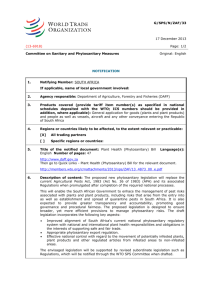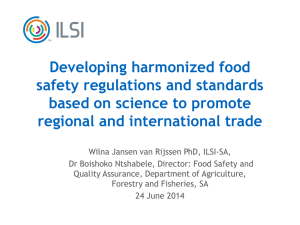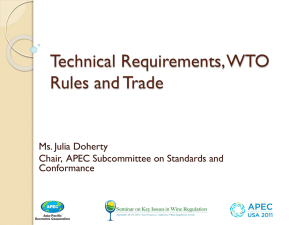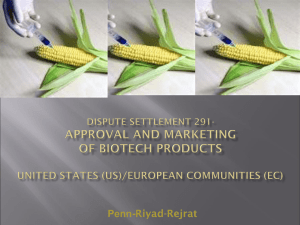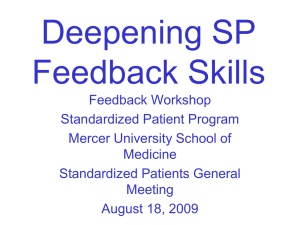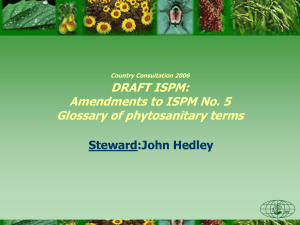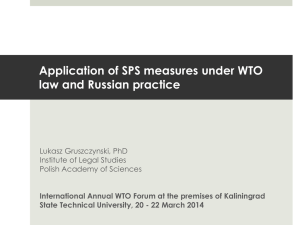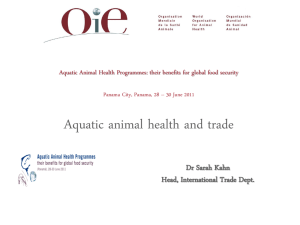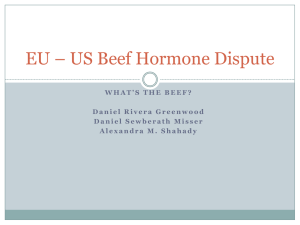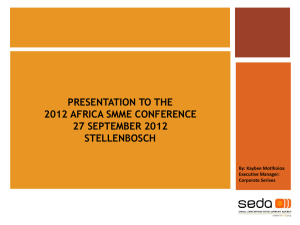Directorate: Plant Health - Department of Agriculture
advertisement
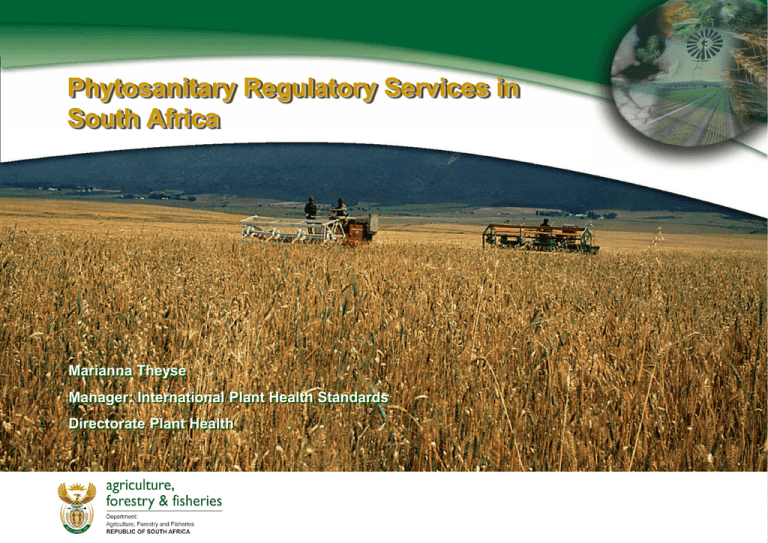
Phytosanitary Regulatory Services in South Africa Marianna Theyse Manager: International Plant Health Standards Directorate Plant Health Scope of presentation 1. Introduction 2. WTO SPS Agreement 3. International Plant Protection Convention (IPPC) 4. National PH Regulatory Services = National Plant Protection Organisation of South Africa (NPPOZA) 5. Market Access and Maintenance 6. SA challenges relating to international trade 7. Conclusion 2 Introduction SA is an active trader in the global import/export market of agric product Trading of plants & plant products = risk of pests and diseases introduction into importing country SA = signatory member of various multilateral and bilateral trade agreements SA membership = opportunity to export its agricultural products to different international markets (fruits, vegetables, seeds etc) 3 WTO SPS Agreement SA=Signatory member of WTO- SPS (Agreement on the Application of Sanitary & Phytosanitary Measures) Sets rules for global trade of agricultural products Subscribes to the principle of equal market access and international cooperation in protecting human, animal and plant Health WTO SPS gives members rights & obligation to: Protect the humans, plants & animals from foreign pests (i.e. set phytosanitary regulations) Regulatory measures based on scientific data (i.e. technical justified & appropriate) 4 WTO SPS Agreement cont. “Sanitary” refers to Human and/ or animal health and officially controlled human and/or animal pests and diseases, toxins and other contaminants “Phytosanitary” refers to plant health and officially controlled plant pests and diseases “Measure” refers to any Legislation, regulation or official procedure for preventing the impact of regulated pests 5 WTO SPS compliance cont. Provisions of WTO SPS *Harmonization = use ISPMs Where relevant international standards/ relevant guides exist, Member shall use them or relevant part of them as a basis for their technical regulations, standards or conformity assessments *Equivalence = Members shall, upon request, enter into consultations with the aim of achieving bilateral and multilateral agreements on recognition of the equivalence of specified SPS measures, even when they differ from theirs, provided that they fulfill their objective or provide the appropriate level of protection (ALOP). ALOP = the level of protection deemed appropriate by the Member establishing a sanitary or phytosanitary measure to protect human, animal, or plant health or life within its territory. This concept is also referred to as “acceptable level of risk” 6 WTO SPS compliance cont. Provisions of WTO SPS *Assessment of Risk and Determination of the Appropriate Level of SPS Protection = PRA SPS measures based on risk assessment developed by relevant international standard setting bodies In assessing the risk to animal or plant life or health and determining the measure to be applied for achieving the ALOP, Members shall take into account - scientific evidence - economic factors - and minimizing negative trade effects Ensure consistency in the application of the concept of ALOP Where relevant scientific evidence is insufficient, a Member may provisionally adopt SPS measures on the basis of available pertinent information – Precautionary principle. 7 WTO SPS compliance cont. Provisions of WTO SPS *Adaptation to Regional Conditions, incl. Pest- or Disease-Free Areas and Areas of Low Pest or Disease Prevalence Ensure that SPS measures are adapted to the SPS characteristics of the area whether all of a country, part of a country, or all or parts of several countries from which the product originated and to which the product is destined. Recognize the concepts of pest- or disease-free areas and areas of low pest or disease prevalence. Exporting Members claiming that areas within their territories are pest- or disease-free areas or areas of low pest or disease prevalence shall provide the necessary evidence thereof in order to objectively demonstrate this to the importing Member. 8 WTO SPS compliance cont. Provisions of WTO SPS *Transparency = IPP at www.ippc.int National Enquiry Points and Notification Authorities established *Control, Inspection and Approval Procedures = APIS Annex C *Discrimination = MFN, NT and Precautionary principle 9 WTO SPS compliance cont. International Standard Setting Bodies Members shall play a full part, within the limits of their resources in the relevant international organizations and their subsidiary bodies - the Codex Alimentarius Commission - the International Office of Epizootics (OIE) - the International Plant Protection Convention (IPPC) Promote within these organizations the development and periodic review of standards, guidelines and recommendations with respect to all aspects of sanitary and phytosanitary measures 10 International Plant Protection Convention (IPPC) Purpose: effective action to prevent the spread and introduction of pests of plants and plant products, and to promote appropriate measures for their control Scope: Covers international cooperation in controlling the introduction of pests associated plants and plants products Extends to items capable of harboring or spread pests, such as: • Storage places, Conveyors / vehicles and containers 11 IPPC: National regulatory services SA membership obligations ito WTO SPS AGREEMENT and specifically the IPPC (NRT 97): Members should provide for a NPPO (National Plant Protection Organisation) Conduct pest risk analysis (PRA) Phytosanitary inspection Issue phytosanitary certificates Disinfestation and/ or disinfection of consignments Phytosanitary security of consignments after inspection Surveillance (cultivated and wild) Report pest occurrence, outbreak and spread Control pests Protect endangered areas Designate, maintain and survey PFA’a and ALPP’s Training and development of staff National Plant Protection contact point 12 •NATIONAL PLANT PROTECTION ORGANISATION (NPPO) OF SOUTH AFRICA DIRECTORATE PLANT HEALTH AGRICULTURAL PRODUCT INSPECTION SERVICES Director: Plant Health - MS Alice Baxter (DPH@daff.gov.za) Director: APIS - Mr Mooketsa Ramasodi (DAPIS@daff.gov.za) SUB-DIRECTORATE SUB-DIRECTORATE SUB-DIRECTORATE SUB- SUB-DIRECTORATE SUB-DIRECTORATE International Plant National Plant Health Quarantine Diagnostic DIRECTORATE Port of Entry Point Control National Plant and Health Matters Matters & Infrastructure Port of Entry Point Land Border Posts Plant Product Services Control Seaports NPPO Contact Point, Early Warning Systems Diagnostic Services: Bi- and multilateral & Rapid response: Ms Melanie Arendse Inspections Land Border Posts Gauteng: Ms Poppie Molebatsi Agreements : Ms Marianna Theyse Eastern Cape & Free State: Pest Risk Analysis: National Policy, Norms Ms Isabel and Standards: Quarantine Services: Airports: KZN, Mpumalanga & Bezuidenhout & Mr Limpopo: Victor Mudau Mr Harry Hlakane Western Cape: Plant Health Import Promotion and Infrastructure & Export Protocols: Awareness: Campus Ms Juliet Maja Management: 13 Audit services Market Access and maintenance Relies on: 1 Technically justified measures based on: Pest Risk Analysis Reliable published information Rapid pest identification method Up-to-date survey and pest lists Effective pest mitigation treatments Surveillance for new pests Good agricultural practice 2 Bilateral agreement between NPPOs regarding import requirements 3 Communication & cooperation between role players & stakeholders 4 A record of credibility i.e. the ability to comply with requirements & provide reliable information 5 Active country membership of and participation in the relevant International Standards Setting Bodies, and 6 Implementation of the appropriate international standards (ISPMs) 14 Market Access and maintenance cont. Communication: 1 Export initiation actions are undertaken upon request & in collaboration with respective SA industries 2 Technical meetings regarding access and maintenance of export markets “MAWG” meetings (reps from different industries CGA, Subtrop Growers, Hortgro, PPECB etc) 3 Day to day communication 4 Ongoing communication with trade partner NPPOs 15 Market Access and maintenance cont. Regulating exports: 1Phytosanitary inspections and controls to verify compliance 2 Phytosanitary certification to confirm compliance (phytosanitary certificate) 16 Market Access and maintenance cont. Major established export markets: Citrus – EU, Japan, South Korea, China, Iran, Taiwan, Middle East, USA, Africa, Russia, India Table Grapes: EU, Israel, China, Iran Apples & pears: USA, Taiwan, EU, Mexico Stone fruit: EU Persimmons: EU, Israel Current negotiation with some important importing countries: Litchi – USA Mango – India, China, Japan, Brazil Avocado – India, Brazil Citrus – Australia 17 Market Access and maintenance cont. Some important quarantine pests of concern: Fruit flies (Mediterranean and Natal Fruit Fly) False Codling Moth Citrus greening Citrus Black Spot (PFA) 18 SA’s challenges relating to international trade Capacity constraints related to: Limited scientists to conduct PRA Limited pest survey information for providing to NPPO in target country Scientific information for PRA Inconsistency regarding communication from importing countries Lack of information on import requirements of trade partners Other: Limited cooperation between DoA, Provincial, other departments and the industry/ stakeholders Smuggling Non-compliance of imports Climate change Pest outbreaks (ie Bactrocera invadens, aster yellow phytoplasma etc) 19 CONCLUSION South Africa has a great potential Scientists to access new International markets Effective communication Different (DoA) NPPO Reliable scientific information + Provincial Industries of commodity pests & departments Market access & stakeholders & maintenance diseases Plant health legislation & standards Producers / Assignees farmers Team Work (shared responsibility) 20
